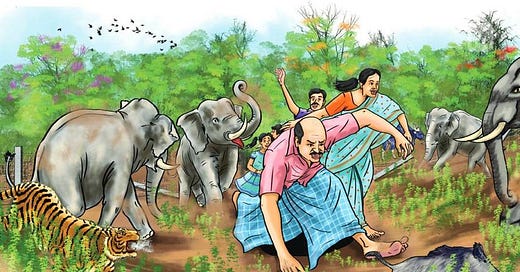The Battle for Survival: Understanding Human-Wildlife Conflict
‘Leopard sightings at IITB Bangalore’… ‘Boy injured during an animal attack in UP’ ‘Recent Tiger attacks fuel anger in Nagpur’...Why are headlines like these becoming increasingly rampant every year?
Earlier this month, I took to my Instagram page, Monica Fatogun to shed light on the economic and ecological significance of Vultures. I commemorated vulture awareness day by sharing my experience working in the conservation of the Hooded Vulture population in LUFASI in Nigeria and discussing an Indian case study highlighting their importance to India’s health sector.
From my experience, animals have always preferred to remain elusive and escape from being seen or heard. Most times when people investigate curiously, the animal tends to feel threatened and cornered which leads to retaliation that can turn fatal. Of course there are exceptions to this where there are other Human-Wildlife Conflict (HWC) cases where animals wander into homes and attack even unprovoked.
During my time as a program officer working within the forests of Sanjay Gandhi National park sprawling with free roaming leopards, I was fortunate to have never been attacked even though I had few encounters with the leopards. Most just bolted into the forest while others watched me pass by. The national park also has Adivasi locals living within the forests who have adapted to perfectly coexisting with the leopards and during my 2 years working there, I heard of no fatal attacks. This global issue with numerous Human-Wildlife conflicts in other African countries like Namibia, Kenya and Nigeria with headlines such as Snakes hidden in homes during the winters or in the toilet commodes and Crocodiles roaming in Miami.
The question is why.
So what is a Human-Wildlife Conflict?
A Human-Wildlife conflict ensues when there are interactions between humans and wildlife lead to negative impacts on either or both of the entities. This usually includes damage to property, agricultural fields, etc. Man coming in contact with wildlife in urban cities and rural areas are very common with cases like
Recent Human-Wildlife Conflicts Data in India.
Odisha has lost 776 elephants in the past decade due to poaching, poisoning, electrocution and accidents.
Electrocution, poisoning of raid-prone crops, and train-hit killed 11 elephants within a week in October 2022 across Assam; these included a mother and calf killed by Rajdhani Express in central Assam’s Jorhat district.
Forest officials came across the ashes believed to be that of a wild animal in an area adjoining the Nagarjunasagar-Srisailam Tiger Reserve. Investigations unearthed poachers setting up electric fence in the to hunt wild animals for their meat.
In Uttarakhand, every month, cases of wildlife animals like leopards, tigers, and elephants attacking humans are reported. Among these, leopard attacks are the most frequent and severe.
If there are some other conflicts I might have missed out, Kindly let me know below,
So what causes these Human-Wildlife Conflicts?
Habitat loss and Fragmentation
According to the UN, we lose 10 million hectares of forests per year meaning it has greatly contributed to the 53% decline of wildlife populations. Deforestation, Agriculture and Constructions of reservoirs, railroads for urbanization and industrial development are some of the major factors causing the reduction of wildlife habitats and the rise of animal sightings in urbanized areas.
Increasing Human Population
As human populations grow exponentially, there is an increase in demand for spaces and settlements. These unequivocally mean expansion into natural habitats or protected areas where wildlife is present. Hence the unprecedented interactions when the trees are felled for construction. This is a rampant case in Nigeria
Ignorance/lack of public awareness
The fear of the unknown and the misunderstandings lead to unnecessary human-wildlife. In Nigeria, there is a crippling lack of pubic awareness in understanding animal behaviours and mannerisms making every animal seen as dangerous which fuels people to kill these animals that might not have been a threat.
Wildlife Trafficking & Poaching
This can be associated with a lack in sensitisation of the ecological and economic benefits of an animal. Animals just get seen as products and trophies especially as there is a high monetary value tagged with each demand for certain wildlife body parts or appendages like the ivory tusks of elephants, the tiger coats, scales of the Pangolin and so on. This pushes people to encroach onto wildlife habitats and set up traps, poisons or physically hunt for them. While they are successful sometimes, in the other times, there are clashes and possible deaths.
What do Human- Wildlife Conflicts lead to?
Injury and loss of life of humans and wildlife
Property/infrastructure damage
Destruction of habitat: Rising human population mean expansion of cities and gradual destruction of natural habitats.
Collapse of wildlife populations: Destruction of wildlife habitats mean reduction of their geographic ranges leading into encroachments.
Loss of livelihood/Crop damage- Elephants raiding into farms and fields damaging farmers crops, hence losing their source of income/ livelihood.
How can we avoid these conflicts?
Habitat Restoration- The need for establishing protected areas and national parks for animals to have space to create or replicate their habitat is required. Another solution is to restore barren areas with vegetation and create wildlife corridors to support the easy movements of wildlife populations. This well supported ecosystem will prevent wildlife from encroachment into urban cities.
Better enforcement and a pragmatic policies: Human-wildlife conflict laws and regulations have to be properly enforced to address the issues of human-wildlife conflict and make room for financial compensation to farmers who have endured livestock losses and property damages.
Increased Public Awareness: People need to be aware of pug identification or elephant warnings in order to prevent retaliation killings. For example, some animals are usually in ‘flight’ mode wanting to flee the scene but it becomes tricky when they come to associate humans with food. So learning to dispose of rubbish properly can help discourage animals from venturing closer to humans.
Human-Wildlife Conflict mitigation measures
Implement solar fencing which is more non-lethal as compared to electrical fencing.
Creation of wildlife corridors in fragmented habitats so animals can move safely from one side to another. Installation of animal warning equipment and wildlife road signs help to avoid accidents.
There needs to be buffer zones created with vegetation to ward off wildlife from households so as to prevent property damage as well as injuries to both parties. For example, Zimbabwean farmers plant chillies on the peripheral regions near their crops to dissuade elephants from coming in (AWF.org).
Some areas in Assam are experimenting with beehive fencing to supplement farmers’ income. Also the emphasis is on the bees as elephants avoid the buzzing, stinging insects.
Implementation of wildlife tracking and warning equipment such as drones, GPS collars, camera traps, etc. can be used to sense and monitor movements to notify the locals when they are close in proximity.
Maintaining 341 water ponds in Wayanad and 249 in Idukki to make water bodies accessible to wild animals. (Kerala Forest Department)
Are there other measures you think I omitted? that needs to be highlighted, do let me know in the comments below.
These conflicts is a complex issue that will require a multifaceted strategic approach which involves a harmonious collaboration between government agencies, wildlife organizations, local communities, and legal and judicial stakeholders. By enforcing these mitigation measures that balances the rights and interests of both humans and animals, each region can pave the way for harmonious coexistence, by ensuring the preservation of its rich biodiversity while safeguarding the well-being of its citizens.
Till next time, remember I’m rooting for you!
Love,
Monica Fatogun






